Historical Overview
The School of Nursing was founded in 1909 as the nation’s first continuously operated university-based school of nursing. In 1909 there were 1,129 schools of nursing in the country, all located within hospitals. Hospital-based nursing education was the accepted norm until the middle of the twentieth century.
The University of Minnesota School for Nurses (as it was known until 1920) was created largely due to the efforts of Dr. Richard Olding Beard, a professor of physiology in the University of Minnesota Medical School who recognized the value of nursing and believed in professional education for women.
Initially, the school offered a three-year program in which four students were enrolled the first year. In 1919, a five-year program leading to a baccalaureate degree in nursing began. The shorter non-degree program continued until 1947.
A comprehensive summary of the School of Nursing’s history is chronicled in Leading the Way, The School of Nursing 1909 to 2009 (written by Laurie K. Glass) which was commissioned to commemorate the school’s first 100 years. This and other historical materials can be obtained through the Alumni Society’s Heritage Committee.
History by Decade
2020 -
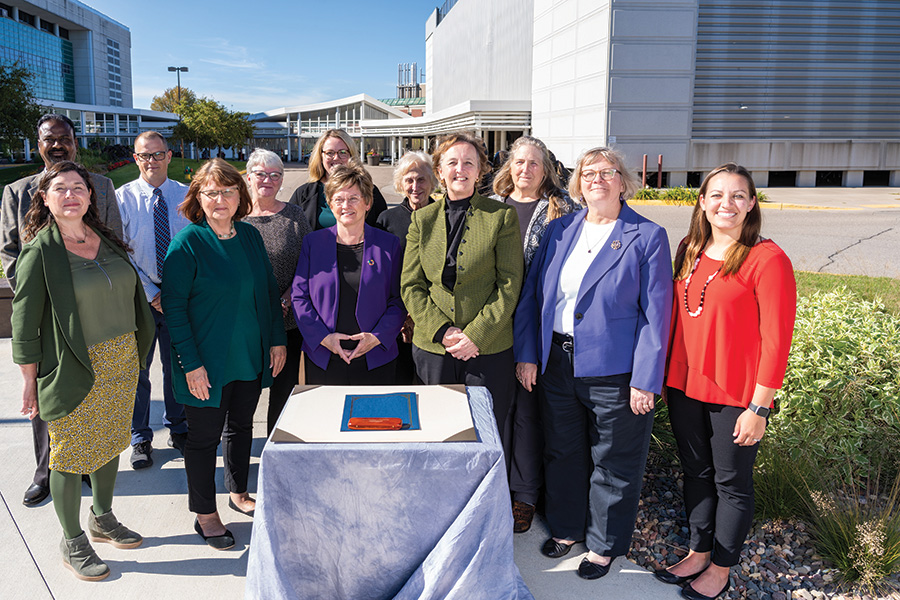
2020
- Covid 19 pandemic required quick changes in class delivery, practicum experiences and faculty work. In 2010 School faculty were part of an interprofessional initiative to prevent global pandemics convened by the U.S. Agency for International Development. The School of Nursing was the only U.S. nursing school involved in the project.
- The School of Nursing and the Medical School developed a plan for using mobile health care for high-risk populations including Covid 19 testing, education, vaccinations. Otto Bremer Trust had donated $1 million for the project.
- School developed digital application - MyStrenghs+MyHealth – to collect data for assessment of health of individuals and communities, (e.g., long covid, decrease in exercise in older adults).
- Schools of Nursing and Public Health conducted research about Covid related stress in health care providers.
2010 - 2019

2010
- National Academy of Sciences Institute of Medicine (IOM) published “The Future of Nursing: Leading Change”. Minnesota joined 15 states to become an IOM coalition.
2012
- The 100th graduating class of nurses joined more than 12,000 alumni including the first graduating class of 1912.
- Celebrations for program leadership milestones; Midwifery program – 40 years, PhD program – 30 years, Centers for Adolescent Nursing and Children with Special Health Care Needs – 20 years
2013
- The 11,000 square foot Bentson Healthy Communities Innovation Center opened. It was designed, constructed, furnished with state-of-the art technology.
- The School ranked 15th among schools of nursing nationally in National Institutes of Health funding for nursing research.
- A collaborative framework was formed to integrate the nursing leadership of the University of Minnesota Medical Center, Children’s Hospital, University of Minnesota Physicians and the School of Nursing designed to share information and identify collaborative efforts to improve the quality of care, student clinical experiences and nursing education programs.
- The largest gift in history was received, $10 million over 10 years to expand the Doctor of Nursing Practice program. The Bentson Foundation gift supports scholarships, and program growth to address shortages in primary care.
- The School and the Minneapolis Veterans Administration Health Care System were awarded a $5.3 million competitive grant to expand the BSN program. The 5 year grant from the federal Department of Veterans Affairs supports program growth of 20 students and provides funding for additional 10 faculty and coordination of student clinical placements at the VA.
- Became one of seven inaugural research partners with Optum Labs, the collaborative research and innovation center founded by Optum and Mayo Clinic. Provided access to information resources, proprietary analytical tools and scientific expertise to help drive the discovery of new applications, testing of new care pathways and other opportunities to drive innovation in wellness care delivery.
2014
- The Vincent Endowed Chair in Public Health Nursing, becomes the 6thendowed faculty Chair /Professorship.
- Agreements signed with University of Minnesota Morris, University of Minnesota Crookston, University of Minnesota Duluth and University Minnesota Rochester for enrollment of qualified graduates in the Master of Nursing program.
- Students, alumni and faculty worked with the CDC to provide Ebola contact tracing in Guinea. Faculty were part of a team charged with training and setting protocols for a 50-bed Ebola Treatment Unit in Liberia.
2015
- The Minnesota APRN Practice Act went into effect. Celebration of the nurse led University of Minnesota Health Nurse Practitioner Clinic.
2017
- Ranked #2 graduate school in nursing informatics by U.S. News and World Report
- ·Hosted the 5th Annual Big Data conference to advance a national plan for sharable comparable data
2019
- Celebration of 110 years
2000 - 2009
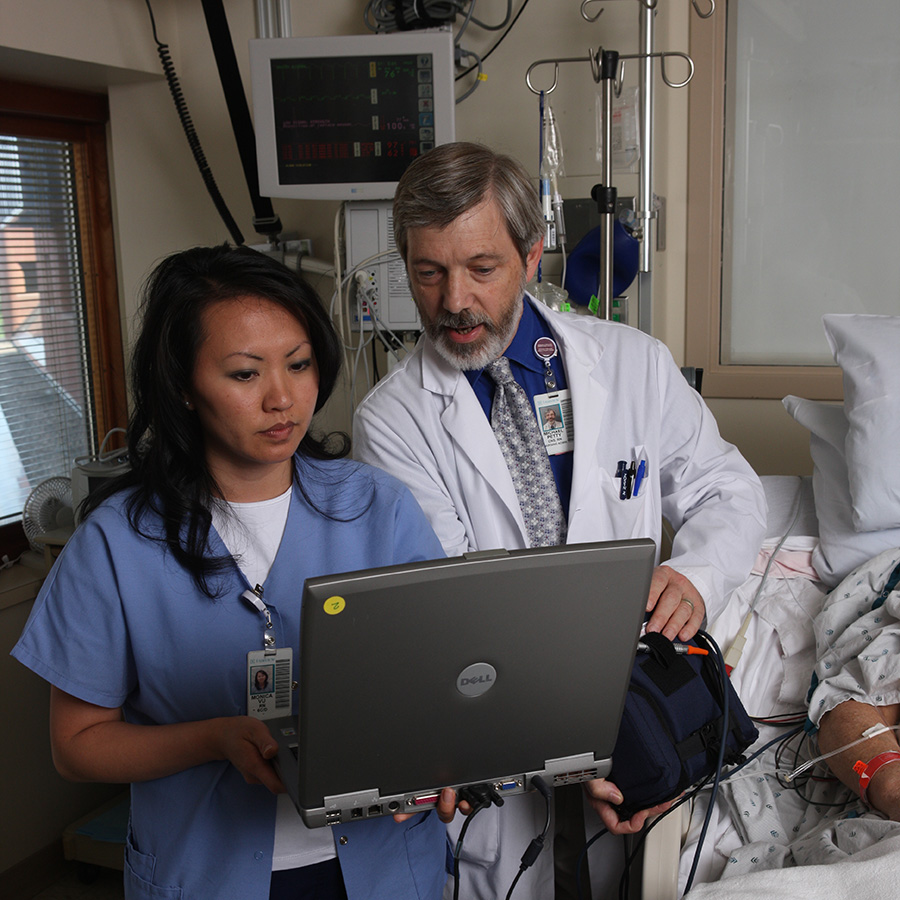
2000
- Joanne Disch was appointed the director of the Densford Center for Leadership and the first Katharine and C. Walton Lillehei Chair in Nursing Leadership.
- The Public Health Nursing program was ranked 7th in the country by U.S. News & World Report.
2002
- The BSN program was extended to the Rochester campus with 14 students.
- The Post-Baccalaureate certificate program admitted 20 non-nursing college graduates.
2005
- Connie White Delaney was appointed the fifth dean (the 10th leader of the school).
- Graduation Memories by Nikki (Patnode) Read.
2006
- First students graduated from the masters degree Native Nurse Career Opportunity Program. Administered in collaboration with DHHS-Indian Health Services.
2007
- The Doctor of Nursing Practice (DNP) first class was admitted. Doctor of Nursing Practice specialties were offered in nursing informatics, integrative health and healing and health innovation and leadership in addition to clinical specialties.
- The post-baccalaureate certificate in nursing program transitioned into a professional Master of Nursing degree program and expanded enrollment.
- The Minnesota Hartford Center for Geriatric Nursing Excellence was established with a one-million-dollar grant from the John A. Hartford Foundation.
2009
- The Centennial Celebration was held in 2009 to honor the school’s rich history. 100 distinguished alumni were honored.
1990 - 1999

1991
- After serving as an interim dean for one year, Sandra Edwardson was appointed fourth dean succeeding Ellen Fahy.
- The Public Health Nursing program was transferred to the School of Nursing from the School of Public Health.
- The Gerontology Clinical Nurse Specialist and Nurse Practitioner programs were introduced. The School of Nursing became a national leader in research for long term care of the elderly.
1992
- The Pediatric Nurse Practitioner program was added to the curriculum.
- A partnership was established with Moorhead State University to offer graduate nursing courses to educate nurses for health care delivery in the rural areas as well as serving Native American and immigrant populations.
1993
- The Family Nurse Practitioner program was added, and the faculty practice plan approved.
- The Center for Adolescent Nursing was created, the only international federally funded center for those who specialize in adolescent health.
- The Center for Children with Special Health Care Needs was established with support from the federal government.
1997
- The school received a grant for distance education. Five courses were delivered off site by televideo and the internet.
- The building (Unit F) that housed the College of Pharmacy and School of Nursing was named Weaver-Densford Hall.
- The Katharine J. Densford International Center for Leadership in Nursing opened.
1999
Complementary Care graduate studies minor was approved. This interdisciplinary program was housed in the School of Nursing for 3 years before the Center for Spirituality and Healing was created in the Academic Health Center. It was the first in the country.
1980 - 1989
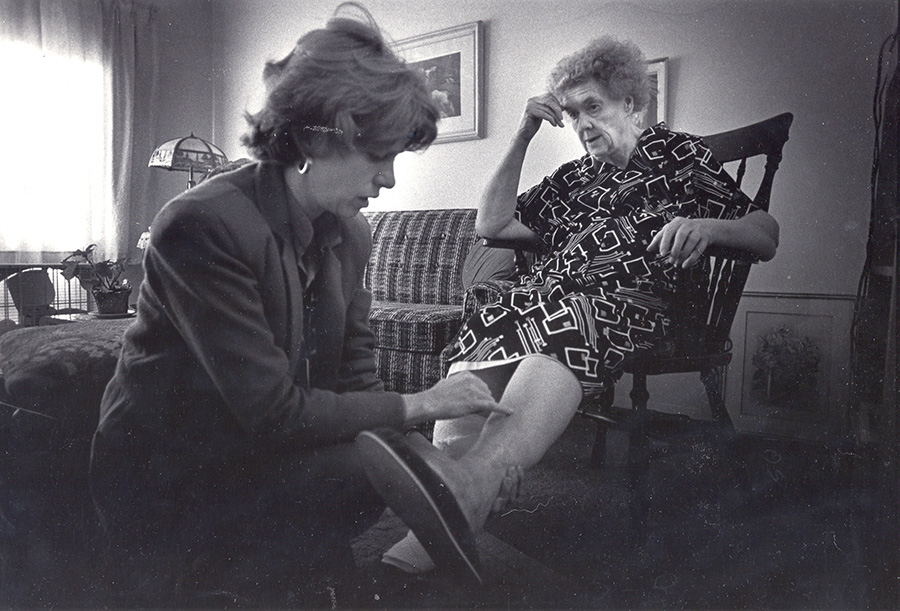
1980
- Ellen Fahy was appointed the third Dean.
- The nursing doctoral program proposal was submitted to the Graduate School. It was approved in 1982.
- The first development officer was appointed.
1981
- The school moved to its new home shared with the College of Pharmacy. The building was later named Weaver-Densford Hall.
- An endowment fund was established for the Cora Meidl Siehl Chair in Nursing Research for Improved Patient Care. In 1984 Sue K. Donaldson was named the first chair.
- 34 of the 50 faculty were engaged in research.
1983
- The Diamond Jubilee (75th anniversary) celebration was held.
- First students admitted to the PhD program.
1987
- The first PhD student in nursing graduated in 1987.
1988
- Upper division curriculum changes occurred: acute care in the junior year, community health senior year, a critical care course in the summer.
- Judith Graves, the first nurse informatician in the U.S. with formal academic preparation finished her postdoctoral experience at the University of Minnesota.
1970 - 1979

1971
- The last capping ceremony was held at graduation.
- Class of 1971 Memories by Jane Covey Hovland (PDF)
1972
- Ida Martinson was appointed director of the first research center. A five-year federal grant was received to improve research at the school.
1973
- The Nurse Midwifery program was established.
- The School created a task force to study the feasibility of a doctoral nursing program at the University.
1975
- Irene Ramey was appointed the second dean of the school. She succeeded M. Isabel Harris.
1977
- Planning and fundraising for a new building to house the school of nursing was underway.
1979
- Inez Hinsvark was appointed acting dean after Irene Ramey’s death.
1960 - 1969
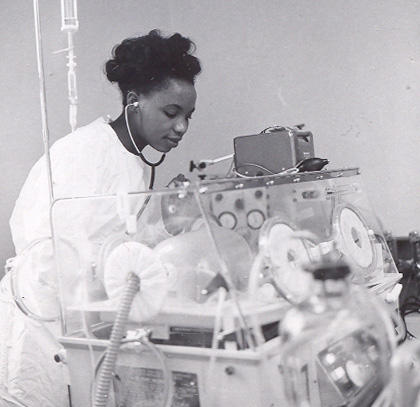
1961
- Visiting faculty taught the school’s first Research in Nursing course.
1961-1965
- Transition to students no longer providing nursing service to the hospital in exchange for room and board.
1962
- Students no longer were required to live on campus in Powell Hall.
- Journey through Nursing School Memories by Lynn Soppeland Assimacopoulos (PDF)
1963
- Psychiatric nursing is the first clinical area in the Master of Science program in the Graduate School.
1965
- Master of Science degree in medical-surgical nursing was added to Graduate curriculum.
- The Public Health Nurse Practitioner program with a master’s degree was established in the School of Public Health.
- The last class from the 5-year program graduated.
1968
- Class of 1968 Memories (PDF)
1969
- The Health Sciences unit was created within the University. This meant the School of Nursing became independent of the Medical School. M. Isabel Harris appointed acting Dean of the School of Nursing and became the first dean in 1970.
1950 - 1959
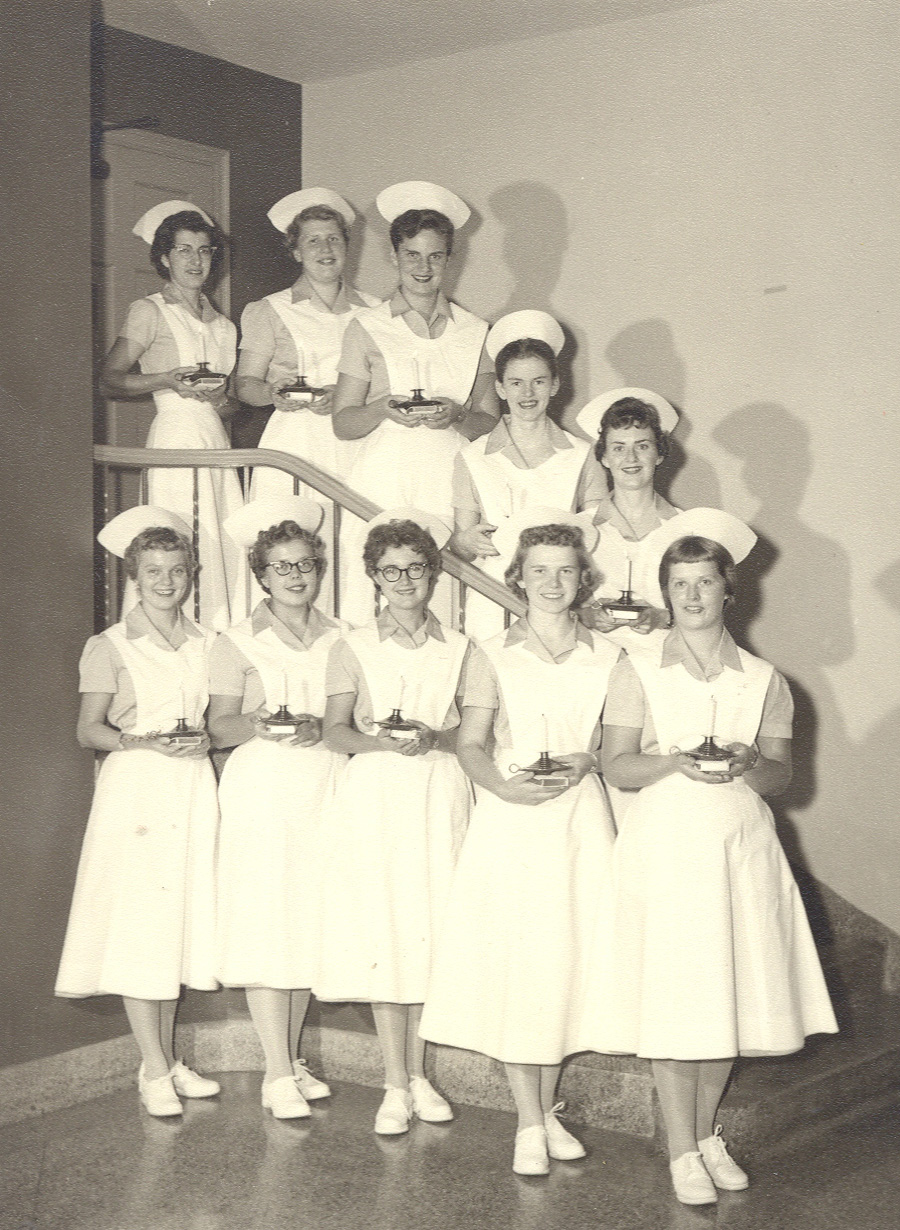
1950
- The first master’s degree program opened with a major in nursing education (degree given by the College of Education).
1951
- A master’s degree in nursing administration was added.
1954
- The faculty assisted in the rehabilitation of nursing education in Korea after the Korean War. The school established a working relationship with Seoul National University. In partnership with medicine, agriculture and engineering.
1958
- Elva Walker Spillane was the first president of the School of Nursing Foundation that was established by Katharine Densford as an independent foundation. The school was one of the first to have its own foundation which later joined with the University of Minnesota Foundation.
- The School of Nursing Alumnae Association joined the University’s General Alumni Association.
- Class of March 1958 Memories (PDF)
- Class of August 1958 Memories (PDF)
1959
- Katharine Densford retired as director after 29 years leading the school.
- Edna L. Fritz was appointed director to succeed Katharine Densford.
- The school’s fiftieth anniversary was celebrated.
- Friendships Built at the U (Minnesota Alumni Magazine Winter 2017)
- Memories by Joy Shin (PDF)
1940 - 1949
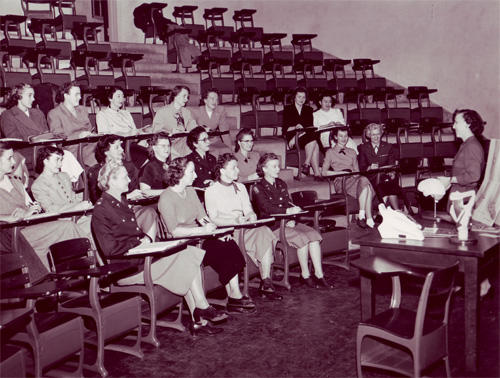
1942
- The 26th General Hospital, sponsored by the University of Minnesota, was officially activated at Fort Sill, Oklahoma in support of the war effort. Many nurses and doctors from the General Hospital joined this unit. Cecilia Hauge (Superintendent of Nurses at University Hospital and faculty member) was appointed Chief Nurse.
- Non-nursing college graduates were admitted to a special 2 ½ year curriculum in an effort to increase the number of available nurses more quickly.
- Class of 1948 Memories by Norma Ellen Knox (Anderson) (PDF)
1943
- During World War II, the school of nursing trained the largest group of nursing students in the nation for the US Cadet Nurse Corps of the US Public Health Service. 1215 nurses were trained.
- A Rural Nursing Demonstration Project for student experiences was funded by federal money. This led to a graduate student project in rural nursing in 1945 with the W.K. Kellogg Foundation support. Over the years, the school has been a national leader in delivery of care to people in rural areas.
1944
- H. Phoebe Gordon returned as an assistant professor and a full time student counselor. It was the first school of nursing full time position in counseling.
- There was a drastic increase in enrollment due to WWII needs. Total enrollment was 982 students versus 285 students in 1939.
- 1944 Memories from Ellen Wolfson (PDF)
1945
- Advanced training for psychiatric nurses was conducted as requested by the American Psychiatric Association.
- Katharine Densford, as President of the American Nurses Association, testified to the Military Affairs Committee of the U.S. House of Representatives speaking against the possibility of a military draft for nurses.
- Class of 1945 Memories from Virginia Heinzmann (PDF)
- 1945 Memories from Shirley Small (PDF)
- 1945 Memories from Betty Heinemann (PDF)
1946
1947
- A 4 quarter practical nurse program was created as an experiment in the University’s General College. (Closed in 1967.)
1948
- The W. K. Kellogg Foundation funded graduate nurse programs in 7 specialty areas that created the first postwar clinical specialist courses.
- Class of 1948 Memories (PDF)
1949
- The first four men were admitted as nursing students; this was about 10 years ahead of the rest of the nation. There were six men in the state who were RNs.
1930 - 1939

1930
- Katharine J. Densford was appointed Director of Nurses, succeeding Marion L. Vannier.
- Courses in clinical fields were created and offered for Registered Nurses.
1931
- The Kardex patient treatment and medication system was created by Barbara Thompson and Mabel Larson Roach.
1932
- Ward based clinical instruction was introduced by Myrtle Hodgkins Coe.
- The Group method of rotating students to clinical services was introduced.
- The school now had a total of 847 graduates, including 84 from the BS degree program.
1933
- The Nurses Hall was dedicated. It was later named Powell Hall in honor of Louise Powell in 1939. This was the first time the university named a building after a living person.
- A School of Nursing graduate, Ellen Church, was the first Boeing flight nurse and had the idea of airline attendants. She hired the first 8 stewardesses in 1930.
1934
- The School of Nursing used photographs and later, motion pictures to teach nursing procedures, a WPA funded project.
- There was a total aggregate of 1026 graduates, including 122 from the BS program.
- The Epsilon chapter of the nursing honor society Sigma Theta Tau was chartered. It was only the 5th chapter in the country. Later changed to Zeta chapter.
- A 6 week course in public health nursing was added to the curriculum.
1937
- Psychiatric nursing content was added to the curriculum.
1920 - 1929

1920
- April 14; Regents authorize a new name for the School for Nurses: the School of Nursing.
- The first Nursing Alumnae Quarterly magazine was published in 1920.
1923
- The School of Nursing had a total of 157 graduates since the school opened.
1924
- Marion L. Vannier succeeded Powell as director of the school.
1925
- Deborah MacLurg was appointed instructor and introduced the case method of assignments to the nursing students.
- H.Phoebe Gordon was appointed as full time secretary.
- A cape was added to the uniform, maroon with gold lining.
- 1925 Alumna Memories (PDF)
1927
- Beta Chapter of Alpha Tau Delta, a nursing service fraternity, was chartered for university students.
1928
- Two courses for graduate nurses were added -Administration in Schools of Nursing and Ward Teaching and Administration.
1929
- Marion Vannier and Barbara Thompson publish the first edition of A Textbook of Nursing Techniques.
- Lucile Petry was appointed an instructor.
1909 - 1919

1909
- The first director was Bertha Erdman 1909-1910. She retired from her position after developing Tuberculosis.
- The first students were admitted to the three-year nursing program.
- The School for Nurses now known as the School of Nursing existed for two years before the University’s hospital opened. In 1909 two campus houses were used as hospital buildings. The hospital was built and opened in 1911.
- The University of Minnesota School of Nursing remains the longest continuously operating university nursing program in the world.
1910
- Louise M. Powell was appointed director of nurses.
1912
- The first students graduated- 8 students
1914
- Convened first official meeting of the Alumnae Association of the University of Minnesota School for Nurses– now known as the Nursing Alumni Society.
1917
- World War I -Navy Corpsman were trained by the school.
- The School for Nurses supported the University Hospital in the organization of a unit of nurses and surgeons to train together and to serve overseas during WWI (Base Hospital 26).
- Louise Powell became the acting superintendent of the University Hospital in addition to her directorship and teaching duties in the School for Nurses because Dr. Baldwin, the superintendent, departed to work at the surgeon general's office in Washington, D.C.
1918
- A 4 month course in public health nursing was offered to graduate nurses.
1919
- A five-year program, three years for Nursing and an additional two years for the college degree was established resulting in the Baccalaureate degree.
- 1919 Nursing Memories (PDF)